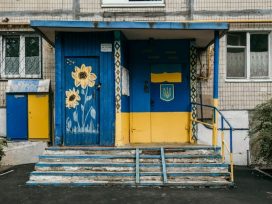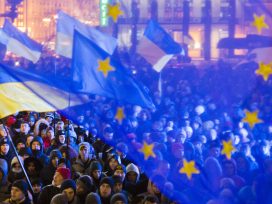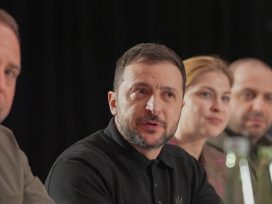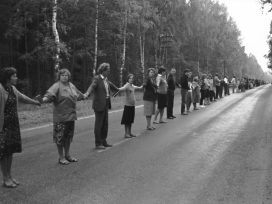When bridges turn out to be walls
The trope of building bridges between peoples on opposing sides of a conflict often seems compelling, and infers an inevitable benevolence. Yet Mykola Riabchuk considers the strategy itself to be misguided, especially when those bridges actually separate people instead of bringing them together.
The only bridge I remember seeing in my childhood was the railway bridge across the Styr River. It separated the city of Lutsk, where I was born, and Rovantsi, a village where I used to spend my summer holidays at my grandparents’ house. The bridge separated two banks of the river rather than connected them. I do not misuse the word: the bridge was closed for civilians and only military personnel from a small garrison nearby were allowed to cross, maintain and guard it from the high towers on both banks.
The adjacent territory was encircled with barbed wire which did not prevent us, little boys, from penetrating the bushes along the banks for berry picking or fishing. But the villagers either had to take a ferry boat down the river to get across to the city, or cross the frozen river on foot when the boat was docked for the winter months. In late autumn when the boat was already docked but the ice was not solid enough to walk on, for a few weeks, the villagers were almost completely cut off from the outside world. If there was an emergency, one could go ten kilometres to reach a car bridge. But nobody really owned a car at that time, so it had to be a real emergency for one to take the boggy road.
Symbol of omnipresence
I have never heard any complaints with regards to the railway bridge that stood attractively nearby but was completely blocked for civilian traffic, even in emergencies. Nobody ever dreamt about this shortcut. It seemed to be blocked not only for people physically, but also for their thoughts. The bridge was a non-object, a non-entity, a kind of theatrical decoration, a Potemkin edifice. Nobody knew why it was guarded so tightly. American spies were barely interested in the marginal object on an obsolete rail line which served just a few trains a day. And saboteurs from the local anti-Soviet guerrilla units were extinguished for more than a decade by then. The bridge was probably devised as a sacral object, a symbol of state omnipresence and vigilance, secrecy and incognizance – according to the best traditions of Franz Kafka.
Maybe this early experience made me highly distrustful of the ‘bridges’ metaphor, as presumably uniting people and nations, or whatever else they manage to connect. Soviet propaganda was abundant in this kind of rhetoric which only exacerbated my distaste for the image. For me, a bridge was actually a wall, a fake, a Kafkaesque object. Later on, I discovered many more simulacra like that – at the Soviet border, and then at the Austrian, German, Italian…
My most recent, and perhaps most relevant, experience comes from Donetsk, a city I visited in 2012 shortly before the war. Of the many remarkable things in the city, I was greatly impressed by the so-called Bridge of Russian-Ukrainian Friendship. It was a weird construction on a high slope of the Kalmius River which resembled a trampoline for jumping into the water, or perhaps a parachute tower, more than a ‘bridge’. It looked like a message to the Russians: ‘We’ve built our five metres, now please do your five hundred.’
The irony was apparently mine, not the designers’. They embellished the bridge with kitschy Soviet-style flags and two opulent ladies (one of them with a Ukrainian traditional wreath on her head, the other one with a Russian kokoshnik, or headdress). Yet the most impressive of all images was one of Winnie-the-Pooh and his friend Piglet walking along the bridge, hand in hand. I was a bit puzzled by the odd symbolism of the particular couple, which had nothing to do with the national or folkloric symbols surrounding them.
Once again I indulged in a heretic assumption that the architect might have meant to be ironic. But who stood for Winnie-the-Pooh and who was Piglet? It looked rather natural that the bear embodies Russia. But why should Ukraine be a piglet? If we reject this politically incorrect interpretation – and we, of course, reject it –, then the opposite, even more subversive interpretation comes to the fore: a huge Mr. Yanukovych, the then-president of Ukraine, resembles the bear, while a dwarfish Mr. Putin looks like the piglet. I expressed my uncertainty to a local friend who accompanied me, and he got startled: ‘Pssst!’ he told me. ‘Don’t speak so loud! Not everybody here would get your jokes!’ So the bridge, once again, appeared to be a wall – as I always suspected. Two years later, more walls were monumentally erected throughout the region.
Walls inside our heads
Back in 2001, I published an article with a provocative title ‘Two Ukraines’. It stirred some controversy as many readers, especially those who never read beyond the title, perceived my essay as a treacherous attempt to split Ukraine into two parts. I was accused of demonizing the eastern part of the country, exaggerating the regional differences, and pouring water on the Kremlin’s mill. The criticisms were merely shooting the messenger or accusing the doctor of causing the illness by his diagnosis. I did not intend to demonize anybody, or deepen historical fissures between the regions. And, moreover, I certainly was not a Putin ally, either by choice or default. By ‘two Ukraines’, I did not mean West and East, or Russian-speaking versus Ukrainian-speaking, or anything like this.
I wrote about two different projects of state/nation building, two different types of identity, and two systems of values. I did not refer to the walls between the regions, but primarily the walls within Ukrainians’ heads. Since 36 per cent of the public have never left their own region, and another 36 per cent have travelled outside their region only once, there is not much of a chance for them to shake their deeply entrenched mutual biases and stereotypes. In 2006 pollsters from the Razumkov Center asked respondents to estimate the proximity between inhabitants of different Ukrainian regions and some neighbouring states ‘in their character, habits and traditions’ along a ten-point scale.1 Predictably, the capital city, Kyiv, and the central part of the country around it were recognized as being closest, while the neighbouring states, from Poland to Turkey, recognized as being the furthest away. There was one exception, however. Russia and Belarus received higher proximity ratings than Ukraine’s own western regions.
While the high rating of closeness to Russia could be explained by the high percentage of ethnic Russians in Ukraine and the de facto dominance of Russian media and culture that tends to glamorize all things Russian, the unusual closeness to Belarus may only have ideological explanations: Belarusians are considered as proximate ‘in character, habits and traditions’ only because this is a persistent mantra, a major part of the Soviet myth about the tripartite East Slavonic nation, still broadly disseminated by Moscow. In fact, Ukrainian citizens have very limited contact with Belarus and their knowledge of Belarusian ‘characters and traditions’ – let alone the language, culture and history – is close to nil. The highly ‘proximate’ Belarusians in the Ukrainian public’s assessment are virtual Belarussians that have little to do with reality.
We may also argue that similarities with Russia in these assessments are imaginary as well as western Ukrainians – who are broadly perceived as almost foreigners (not necessarily ‘worse than us’ but certainly ‘very different from us’). These assessments confirm the vitality of imperial myths and stereotypes still promoted by Russia. As long as myths determine people’s behaviour, they are definitely more important than reality. In the case of Ukraine, it means that the various barriers between the different groups and regions are largely imaginary. It also means that such barriers are very difficult to dismantle insofar as they are based on the myths unamenable to facts and logic.
Painful process of emancipation
In a 2016 survey2 the same pollsters applied a different methodology that makes it difficult to compare the two polls. But at least one peculiarity remained rather stable. Ethnic Russians are still perceived as the closest ‘in culture, traditions, and views’ – as close on a five-point scale as inhabitants of central Ukraine. And western Ukrainians, in both surveys, are still perceived as the ‘furthest away’ – similar to the level of inhabitants in the European Union. This does not mean that western Ukrainians are seen as worse but are still rather alien; just like Russians (and Belarusians) are not seen as better but still ours: part of the imaginary post-Soviet, Orthodox Christian, East Slavonic community. In this way, there are still ‘two Ukraines’, dispersed unequally from the West to Southeast: a Ukraine that seceded for good from the quasi-religious East Slavonic ‘ummah’ a long time ago and a Ukraine that still is in the painful process of emancipation.
In Pierre Boulle’s novel from 1952 Le Pont de la Rivière Kwaï (and the 1957 Oscar-winning film based on the book), the main hero, British Lieutenant Colonel Nicholson, constructs the bridge that ultimately turns out to be a wall – between him and his countryman, his moral integrity and war-time demands, his professional pride and his patriotic duties. The story is fictitious but set in a real environment: the 1943 construction of the Burma Railway that had to connect Rangoon with Kuala Lumpur. Nicholson is one of many prisoners of war forced by the Japanese military authorities to work on the project. He appears to be an honest and courageous man, with a lot of dignity and strong principles. Nonetheless, he collaborates with the enemies and, as a senior officer, makes his subordinates work honestly and efficiently with no acts of sabotage, either active or passive.
He is not driven by any personal interest but a sincere belief in the importance of work: the war will once be over but the bridge would remain and would serve the people. Moreover, he is confident that the British POWs should prove their superiority over the Japanese in both labour skills and technology. At the end, he tries to rescue the newly constructed bridge from his fellow countrymen who plan to blow it up, and he pays with his life for his perverse professional pride and distorted perfectionism.
Not the right time
Since 2014, I recall that plot every time I hear calls from my western colleagues to build bridges with Russian friends rather than walls, to shake hands and hold dialogue. The war will be over, they say, but the translations will serve future generations, the songs will be sung by millions in both countries, and the friendly family ties should be not sacrificed for the sake of a transient and presumably minor squabble.3
The problem is that the conflict is neither minor nor, alas, transient. It has at least lasted two centuries and runs not over a piece of land or trade agreement with the EU, but the very essence of the Ukrainian nation and its right to exist as a sovereign entity, with its language, culture and dignity.
I studied in Moscow in the 1980s and had good relations with my Russian fellows, but eventually I lost most of them. This did not happen in 2014 when Russia invaded my country and most Russians cheered it on, but much earlier, in 1991, when we gained independence and all my ex-colleagues responded scornfully, with poorly disguised irritation. ‘We are one nation’, they argued, ‘We’re almost the same people!’ Their notion of ‘sameness’, however, worked only one way: we, Ukrainians, were supposed to become ‘the same’ – but not vice versa.
With all due respect to my western friends and their pacifist souls, I cannot buy into their calls to construct ‘bridges’ with Russia right now, unless and until Russian proxies stop killing my fellow citizens with an active or passive consent of the majority of Putin’s subjects. Once the shooting stops and Russian troops withdraw from Ukrainian territory, only then can we engage in some kind of dialogue and search for eventual modus vivendi.
Until then, all the ‘bridges’ we will try to build will resemble that over the River Kwai. It would help little, if anything, to break the wall of stereotypes that separate Russians from real Ukraine, but it would certainly facilitate the movement of Russian tanks, operatives and toxic propaganda into my country. The argument that the artists who travels to Moscow perform not for Putin but for the good Russian people sounds as odd to me as if it were voiced about the artists performing in Berlin during the Second World War.
These kinds of bridges were misused for decades and brought much harm to Ukraine, as they erected and solidified different walls between, and within, Ukrainian regions. During the war, the only response should be to blow these up and to instead strengthen and protect our borders that separate us from the rogue state to the East, to ensure our security from the political and military threat many western observers find it hard to comprehend. It might be difficult, costly and harmful in many terms, but it is a matter of national survival. I’m very sorry to say this with respect to Lt. Colonel Nicholson and his perfect but very untimely construction skills.
Natsionalna bezpeka i oborona, no. 7, 2006, p. 12, http://razumkov.org.ua/uploads/journal/ukr/NSD79_2006_ukr.pdf
Natsionalna bezpeka i oborona, no. 3-4, 2016, p. 37, http://razumkov.org.ua/uploads/journal/ukr/NSD161-162_2016_ukr.pdf
For a balanced and comprehensive analysis of the problem see: Andriy Portnov, 'Russia-Ukraine. A dialogue amidst the war?' Intersection, 25 June 2015; See also my earlier article in Eurozine: 'Defining censorship during a conflict'
Published 7 June 2019
Original in English
First published by New Eastern Europe 3-4/2019
Contributed by Mykola Riabchuk / New Eastern Europe © Mykola Riabchuk / New Eastern europe / Eurozine
PDF/PRINTNewsletter
Subscribe to know what’s worth thinking about.
Related Articles

Ukraine faces its greatest diplomatic challenge yet, as the Trump administration succumbs to disinformation and blames them for the Russian aggression. How can they navigate the storm?

Mineral rush
Topical: Critical raw materials
Why does peace in Ukraine hang on a ‘mineral deal’ whose handling is more reminiscent of trade than negotiations? Perhaps because the global race for critical raw material mining is well and truly underway, digging for today’s equivalent of gold: raw earth elements and lithium critical for renewables and digital technology but also modern weaponry.







